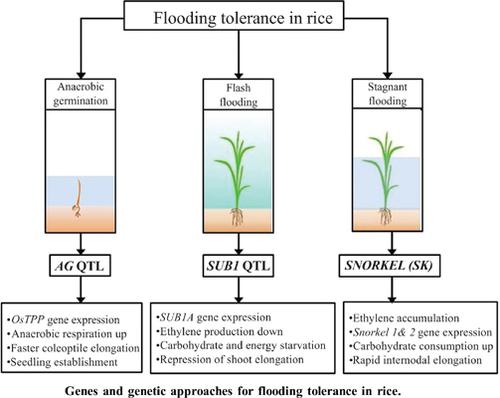Current Genomics ( IF 1.8 ) Pub Date : 2020-12-31 , DOI: 10.2174/1389202922666210114104140 Debabrata Panda 1 , Jijnasa Barik 1 , Ramani K Sarkar 2

|
Flooding is one of the most hazardous natural disasters and a major stress constraint to rice production throughout the world, which results in huge economic losses. The frequency and duration of flooding is predicted to increase in near future as a result of global climate change. Breeding of flooding tolerance in rice is a challenging task because of the complexity of the component traits, screening technique, environmental factors and genetic interactions. A great progress has been made during last two decades to find out the flooding tolerance mechanism in rice. An important breakthrough in submergence research was achieved by the identification of major quantitative trait locus (QTL) SUB1 in rice chromosomes that acts as the primary contributor for tolerance. This enabled the use of marker-assisted backcrossing (MABC) to transfer SUB1 QTL into popular varieties which showed yield advantages in flood prone areas. However, SUB1 varieties are not always tolerant to stagnant flooding and flooding during germination stage. So, gene pyramiding approach can be used by combining several important traits to develop new breeding rice lines that confer tolerances to different types of flooding. This review highlights the important germplasm/genetic resources of rice to different types of flooding stress. A brief discussion on the genes and genetic mechanism in rice exhibited to different types of flooding tolerance was discussed for the development of flood tolerant rice variety. Further research on developing multiple stresses tolerant rice can be achieved by combining SUB1 with other tolerance traits/genes for wider adaptation in the rain-fed rice ecosystems.
中文翻译:

水稻抗洪遗传资源,基因和遗传方法的最新进展
洪水是最危险的自然灾害之一,也是全世界大米生产的主要压力制约因素,造成巨大的经济损失。由于全球气候变化,预计洪水的频率和持续时间在不久的将来会增加。水稻的耐旱性育种是一项艰巨的任务,因为其成分性状,筛选技术,环境因素和遗传相互作用非常复杂。在过去的二十年中,在寻找水稻的耐水机理方面已经取得了很大的进步。通过鉴定水稻染色体中主要的数量性状基因座(QTL)SUB1,这是淹没研究的重要突破,它是耐受性的主要贡献者。这使得能够使用标记辅助回交(MABC)将SUB1 QTL转移到受欢迎的品种中,这些品种在易发洪水地区表现出单产优势。但是,SUB1品种并不总是能忍受停滞的洪水和发芽期的洪水。因此,可以通过结合几个重要性状来使用基因金字塔方法来开发赋予不同类型洪水耐受性的新育种水稻品系。这篇综述强调了水稻对不同类型的洪水胁迫的重要种质/遗传资源。简要讨论了水稻对不同类型的耐水性表现出的基因和遗传机制,以期开发耐水水稻品种。











































 京公网安备 11010802027423号
京公网安备 11010802027423号